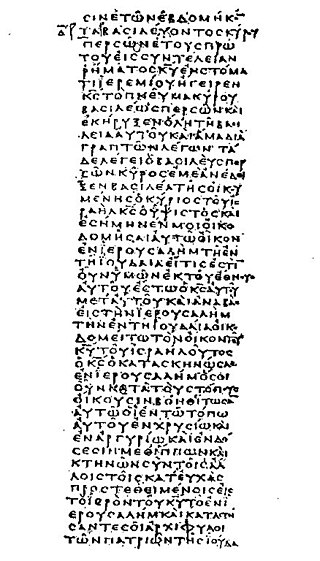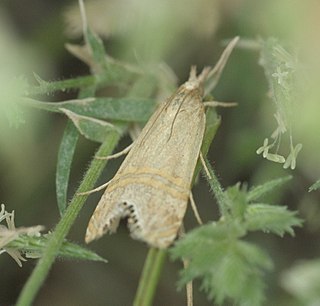
The Septuagint, sometimes referred to as the Greek Old Testament or The Translation of the Seventy, and often abbreviated as LXX, is the earliest extant Greek translation of the Hebrew Bible from the original Hebrew. The full Greek title derives from the story recorded in the Letter of Aristeas to Philocrates that "the laws of the Jews" were translated into the Greek language at the request of Ptolemy II Philadelphus by seventy-two Hebrew translators—six from each of the Twelve Tribes of Israel.
Alfred Rahlfs was a German Biblical scholar. He was a member of the history of religions school. He is known for his edition of the Septuagint published in 1935.

Papyrus Oxyrhynchus 846 is a 6th-century manuscript of a portion of the Greek version of the Hebrew Bible known as the Septuagint. It is one of the manuscripts discovered in Oxyrhynchus, was cataloged under the number 846. Palaeographically dates back to the sixth century CE. It contains Amos 2:6-12. It has been numbered as 906 in the list of Septuagint manuscripts according to classification by Alfreda Rahlfs.
Papyrus 12, α 1033, designated by siglum 𝔓12, is an early copy of the New Testament in Greek. It is a papyrus manuscript of the Epistle to the Hebrews, it contains only Hebrews 1:1. The manuscript palaeographically has been assigned to ca. 285. It may have been a writing exercise or an amulet.

Euchromius is a genus of moths of the family Crambidae. It was described by Achille Guenée in 1845.
Pethor or Petor (פְּתוֹר) in the Hebrew Bible is the home of the prophet Balaam. In the Book of Numbers, Pethor is described as being located "by the river of the land of the children of his people". The River usually refers in the Bible to the Euphrates River, the rest of the description is somewhat vague and perhaps corrupted. In Deuteronomy, Baalam is from "Pethor of Mesopotamia". It is widely accepted that Pethor is the town Pitru, which is mentioned in ancient Assyrian records.

Codex Marchalianus designated by siglum Q is a 6th-century Greek manuscript copy of the Greek version of the Hebrew Bible known as the Septuagint. The text was written on vellum in uncial letters. Palaeographically it has been assigned to the 6th century. Marginal annotations were later added to the copy of the Scripture text, the early ones being of importance for a study of the history of the Septuagint.

Papyrus Rylands 458 is a manuscript of the Pentateuch in the Greek Septuagint version of the Hebrew Bible. It is a roll made from papyrus, which has survived in a very fragmentary condition. It is designated by the number 957 on the list of Septuagint manuscripts according to the numbering system devised by biblical scholar Alfred Rahlfs. Using the study of comparative writing styles (palaeography), the manuscript has been dated to the middle of the 2nd century BCE.
Chrysoclista is a genus of moths of the family Agonoxenidae described by Henry Tibbats Stainton in 1854.
Chrysoclista zagulajevi is a species of moth of the family Agonoxenidae. It is found in Georgia and Adjara (Transcaucasia).
Ochromolopis zagulajevi is a moth of the family Epermeniidae. It is found in the central part of Povolzh’je, northern Ukraine, the Crimea, the Caucasus Mountains, Transcaucasia and western Kazakhstan.
Filatima zagulajevi is a moth of the family Gelechiidae. It is found in the European part of southern Russia.
Euchromius zagulajevi is a moth in the family Crambidae. It was described by Stanisław Błeszyński in 1965. It is found in Turkmenistan.

Ochromolopis is a genus of moths in the family Epermeniidae described by Jacob Hübner in 1824.
Scrobipalpa zagulajevi is a moth in the family Gelechiidae. It was described by Alexandr L. Lvovsky and Vladimir I. Piskunov in 1989. It is found in Mongolia.
The Berlin Genesis, designated as Rahlfs 911, is a 3rd or 4th century manuscript on papyrus. It contains the text of Genesis 1:18-38:5 in Greek. Michael Theophilos says "This manuscript is especially important textually due to the lacuna of Gen. 1:1–46:28a in Vaticanus."

The Roman Septuagint, also known as the Sixtine Septuagint or the Roman Sixtine Septuagint, is an edition of the Septuagint published in 1587, and commissioned by Pope Sixtus V.

Alfred Rahlfs' edition of the Septuagint, sometimes called Rahlfs' Septuagint or Rahlfs' Septuaginta, is a critical edition of the Septuagint published for the first time in 1935 by the German philologist Alfred Rahlfs. This edition is the most widely spread edition of the Septuagint.







